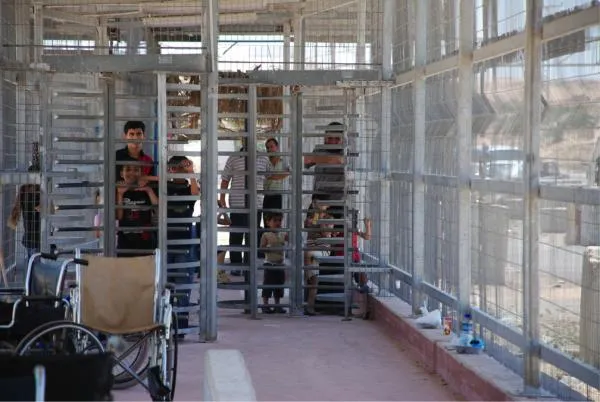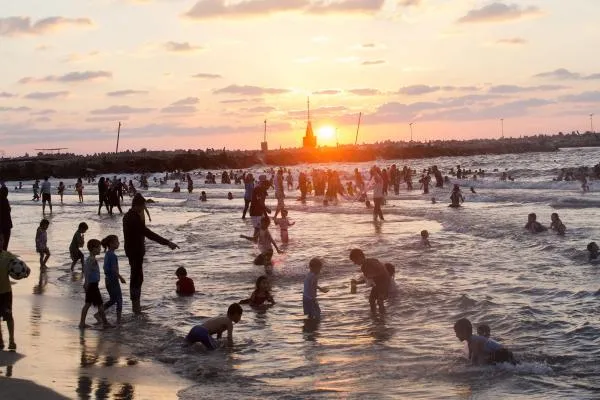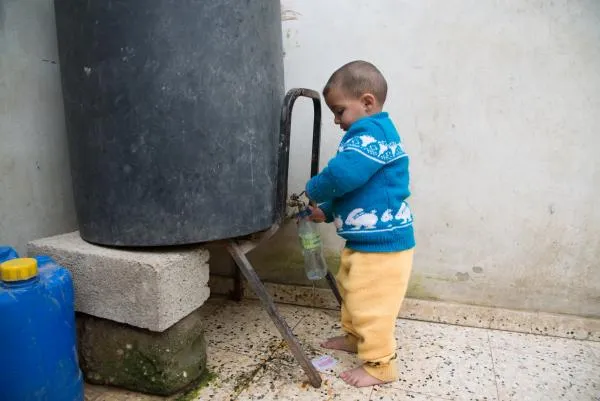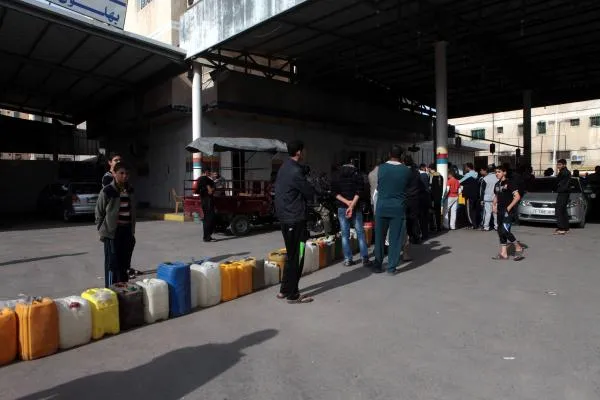Over the last twelve years I have traversed this path into Gaza at least once each year, often more frequently, and I have watched as the rubble that remained after Israel destroyed the Erez industrial zone has disappeared into the surrounding landscape, ground down by tanks during multiple invasions and grown over by weeds.
Over the last twelve years I have traversed this path into Gaza at least once each year, often more frequently, and I have watched as the rubble that remained after Israel destroyed the Erez industrial zone has disappeared into the surrounding landscape, ground down by tanks during multiple invasions and grown over by weeds.
Gaza is surrounded by a wall. Near the Erez crossing point with Israel the wall is made of nearly twenty-foot-tall cement blocks topped by remote-controlled machine-gun nests. Those granted access to Gaza by Israel at Erez must walk through a maze of corridors, turnstiles, and sliding doors inside the crossing terminal before passing through the wall into Gaza. Once in Gaza you are faced with a nearly half-mile walk through an encaged tunnel that leads through a strip of no man’s land to a set of mobile trailers where you are welcomed into Gaza.

It has now been five years since the last large Israeli attack on Gaza and the physical damage and destruction caused by repeated bombings and invasions is now less visible in many locations. However, the destruction wrought by over thirteen years of blockade can be seen everywhere.
From Erez I drove south to Rafah where AFSC recently implemented a humanitarian assistance program for elderly Gaza residents. We drove to Rafah along the coastal road, passing through Gaza city and a variety of other villages and refugee camps. In Gaza City the road near the coast has been rebuilt with funding from Qatar. The new road is lined with wide sidewalks and at night these sidewalks fill with young people and families out for an evening stroll and to socialize. Carts sell boiled corn and kebabs and makeshift beach tea stalls are filled with plastic chairs where people can sit and talk until late into the night. On weekends during the summer people come to enjoy the beach and to spend time with their families.

But as you travel outside of Gaza city the destruction of the last decade becomes clearer. As you drive down the coast the stink of sewage fills the air and takes away from the beautiful Mediterranean views. Sanitation infrastructure has been destroyed or degraded over the course of the blockade and replacement parts cannot be imported. Nearly 29 million gallons of raw sewage, the equivalent of 43 Olympic size swimming pools, is dumped into the Mediterranean Sea every day. The beautiful water that stretches out from the Gaza shore is now highly polluted and that pollution does not stay contained within Gaza.
Pollution is not the only water related problem in Gaza. Over 96% of Gaza’s water supply is not fit for human consumption, having become overly salinated as a result of overexploitation and pollution. Water must be rationed, and people only receive water in their homes for 6 to 8 hours once every four days. Over 5% of the population has no access to running water.

Driving through Rafah what is most noticeable is the lack of cars. Gaza is one of the most densely populated places on earth and Rafah is home to at least 150,000 people. However, in the middle of the day in Rafah we saw more horse drawn carts than cars in the street. This again is a product of the blockade. Closed borders, blocked imports and exports, limited access to electricity and water, and damaged infrastructure have forced over 90% of industry to close in Gaza. Unemployment rates are now over 40%, among the highest in the world, and over 80% of the population relies on international assistance to survive. Fuel imports are restricted and gas prices are high. Many people simply can’t afford to drive.

In the evening one of my colleagues took me out for knafe (a Palestinian dessert) and we walked near the beach. Driving through Gaza at night is a strange experience. Gaza is one of the most densely populated places on earth and Gaza City is a huge metropolis, but at night the city is dark. Huge apartment blocks are black, no streetlights shine, small battery powered lamps light a few shops and generators light a very few locations, but overall the city is black. The electrical infrastructure in Gaza has also been damaged or degraded over the last 13 years and cannot be rebuilt because of the blockade. Most people receive no more than four to six hours of electricity per day.

When I returned to Erez on my trip out of Gaza I was informed at the Palestinian checkpoint that the Israeli military had just called to say that nobody could cross the no man’s land between the Palestinian and Israeli sides of the checkpoint for an hour and a half. As I sat at the crossing constant one-way gunfire sounded as the Israeli military fired into Gaza from somewhere nearby. This is such a common occurrence in Gaza that nobody batted an eye as gunfire echoed around us. This is the daily violence present in Gaza that occurs when the media reports “quiet”.
The sound of Israeli gunfire as heard at Erez while waiting to cross out of Gaza.
For twelve years I have watched as Gaza’s infrastructure gradually breaks down under the cumulative impact of the blockade. People in Gaza find ways to work around the hardships and violence they face, but nobody should be forced to live under such oppressive conditions.
The blockade is violent. The blockade is collective punishment. The blockade cannot be justified. The blockade must be ended. Only with an end to the blockade, the occupation, and the systematic inequalities faced by Palestinians under Israeli control can a just peace be realized.

